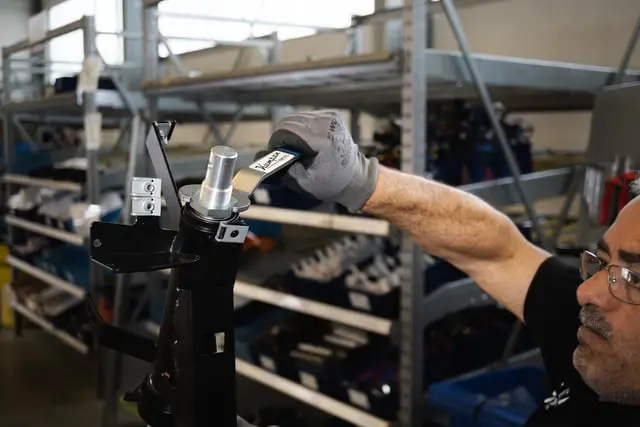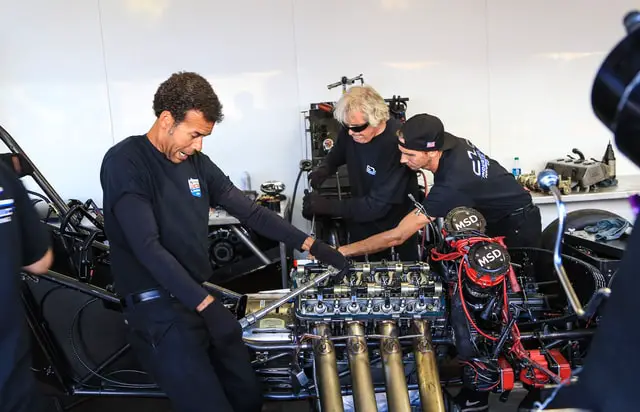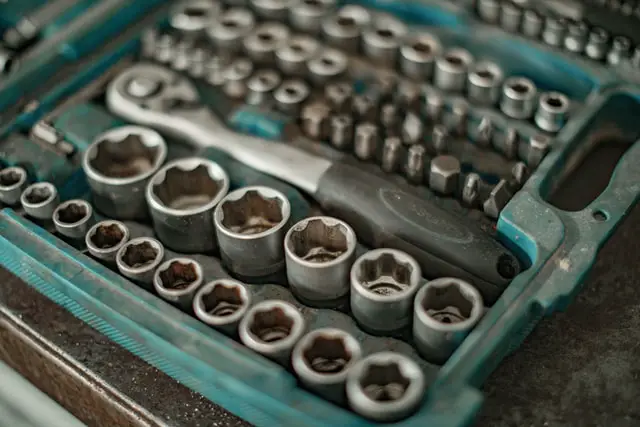If you’re wondering how does a torque wrench work, you’re in the right place. Torque wrenches are tools to apply torque to a fastener to remove or tighten it. You must purchase the correct type of torque wrench for the specific application and follow all manufacturer’s instructions for its use. If you have any questions about your specific torque wrench functions, please consult the manual or contact customer service from the company you purchased. In this article, we will discuss:

Image credit: unsplash.com
What Torques Wrenches Are Used For
There are many different types of torque wrenches, but they all use the same basic principle. The wrench has an internal spring-loaded mechanism that opens when you turn the handle. When you reach the desired torque setting, a calibrated screw closes the opening to a specific size.
If the wrench is calibrated in inch-pounds, it will have an “IP” mark on the handle. When you feel resistance while turning the handle, stop immediately and check to see if you reached your desired torque value by looking at the scale on the handle. Note: Be sure the calibrations start at 0. If you reach your desired torque value and keep turning, you will break the wrench because it does not have a mechanism that releases the tension.
Carefully read all manufacturer’s instructions before using any torque wrench. Also, determine if you need an inch-pound or foot-pound setting to work on your particular project. Some torque wrenches only come in a foot-pound setting and cannot be recalibrated.
Also read: How to Use a Socket Wrench
What Types Of Wrenches Are There?
There are two main types of torque wrenches, clicker, and beam. Clicker wrenches have a circular dial that clicks when you reach your desired torque value and stops turning once you reach the desired setting. Beam wrenches have a rigid bar set between two fixed posts. You turn the handle to set the pressure as indicated on the scale.
How to Use a Torque Wrench Correctly
Safety is always the first concern when working not only with a wrench but also any other tool. Follow all safety precautions for your protection and that of others nearby. Always wear protective eyewear, gloves, and other personal protective equipment (PPE). Also, make sure to use a torque wrench in a well-ventilated area, especially if using an electric tool.
Step 1) Always use the proper torque for your application. This will be indicated in the product manual or on a label on the wrench itself. Using incorrect torque can damage parts of the project. Some of the damages include future problems, and potentially injuring you or someone nearby if it comes apart unexpectedly.
Step 2) Make sure everything is set up and in place before starting. Wrenches only work when they are firmly and correctly attached to the fastener.
Step 3) Check settings on the wrench before starting. Ensure all parts are clean, free of rust or corrosion, lubricated, etc. Remember that if your tool has multiple torque settings, you must select the proper one for your project.
Step 4) Tighten fasteners to your desired torque with smooth, even turns. If using an electric tool or an air pressure wrench, you will hear it begin to click. It happens once you reach your desired setting. For a beam or clicker wrench, tighten until you feel resistance and stop turning immediately.
Step 5) After tightening a fastener, always double-check it with your torque wrench to ensure you reach the desired value. Some fasteners may require more than one application of a specific torque, depending on their size and material composition. When in doubt, over-tighten rather than under-tighten.
Step 6) Once finished, make sure to clean and store your tool according to the manufacturer’s instructions. Be sure to keep it in a safe. Also, keep it in a dry place away from moisture and out of reach of children.
Also read: TEKTON 24320 Review: 1/4-Inch Drive Click Torque Wrench

Tips On Selecting The Right Size And Type Of Torque Wrench For Your Application
When selecting the best type of wrench for your project, many things to consider. First, determine whether you need an inch-pound or foot-pound setting to complete your task. Second, decide between a clicker or beam wrench depending on your preference and your project’s specific needs. The following tips can help you select the best one for your application.
Beam vs. Clicker
Both torque wrenches are durable, easy to use, accurate within 1%, and available in multiple settings. However, they have some notable differences that may influence your decision when selecting a wrench. Beam wrenches are typically less expensive and more accurate in their highest torque range. However, this accuracy decreases as the torque decreases, so it is best to select a wrench with a higher maximum setting if possible.
Clicker wrenches have a built-in gauge that lets you double-check your setting before you begin tightening. However, they are generally more expensive and less accurate in the lower end of their range.
Variable vs. Single Setting Wrenches
When deciding between a wrench with a single setting or one that allows for variable settings, consider your needs as a mechanic or at-home craftsman. A single-setting torque wrench is ideal for low-torque applications, such as applying the correct torque to an oil filter or adjusting the seats on your bike.
Variable-setting wrenches are ideal for high-torque applications, such as tightening lug nuts on a motorcycle wheel, building furniture with loose hardware, repairing door hinges and other fasteners around the house, etc.
There are several important factors to consider when selecting the right size wrench for your job. For inch-pound torque wrenches, you must know the required torque of the fastener that you will be tightening. For foot-pound settings, it is best to use a wrench that has both an audible click and a gauge with clear markings so you can double-check your desired setting after you finish tightening the fastener.
Additionally, consider that many sockets do not fit on ¼ torque wrenches because of their size and weight. Selecting a ½ or 3/8 wrench will make it easier to complete your project quickly and safely.
Also read: How to Read a Torque Wrench

Factors That Affect the Accuracy of a Torque Wrench
Regardless of the model or setting, a well-made torque wrench is accurate to +/-4% in the clockwise direction and +/-6% counterclockwise. Accuracy may decrease depending on how high you set your wrench and any play in the system when you apply force.
Remember that accuracy decreases as the torque you are applying increases since it is more difficult to hold the wrench steady as the torque increases.
Additionally, if you notice your wrench slipping as you apply force, chances are it is not calibrated correctly since calibration can’t be adjusted once the wrench leaves the factory.
Most wrenches can be recalibrated and should come with a procedure in its user manual. It may be helpful to seek out a certified mechanic or other professional for assistance if you are unsure how to recalibrate your wrench.
The materials used to make the handle and head of the wrench can also affect its accuracy. For example, an aluminum head will not be as accurate as one made of high-quality steel because it is softer and less resistant to deformation when you apply force.
Also read: Hydraulic Torque Wrench Reviews in 2021: Best Powerful Working Wrench
How Does A Torque Wrench Work?
When you are shopping for a torque wrench, take into account your needs and the specific requirements of your project. Select a variable-setting or foot-pound torque wrench with an audible click and gauge for high-torque applications requiring greater accuracy. If you are working on low-torque projects that require just a little force to tighten, a beam or clicker torque wrench may be the right choice for you.